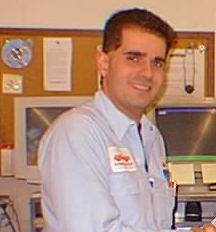Giammalvo Files

Mark Giammalvo specializes in driveability
diagnostics at his family
business, Sam Giammalvo's Auto Sales & Service,
Inc. in New Bedford, MA.
Mark, who has been with the business for
over 20 years, is an ASE Master
Technician and Parts Specialist. He also holds the ASE L1
certification, and has an associates degree in business
management.
Mark is also a writer for Motor Age Magazine
and is the past secretary of the Alliance of Automotive Service
Professionals, (AASP).
|

Climate Change
(Printed in the Journal
of The Alliance of Automotive Service Providers, AASP)
It is interesting to
note how sophisticated automotive electronic climate control systems
have become. Not long ago, I was reading a Volvo Service Bulletin that
addressed normal operation of electronic climate control on a 2002 V70.
A 2002 is not exactly a ‘new' vehicle, but, read on to see how complex
things have already become.
This bulletin referenced many of the interesting inputs and outputs as
well as the central processor that controls this system. Although these
systems are very complex, all this modernization is really transparent
and unknown by most vehicle owners and drivers. One of the items
described was the Air Quality Sensor, (AQS). This sensor, mounted in
the incoming air chimney, detects when outdoor air contains high
concentrations of pollutants. When these pollutants are detected, the
Climate Control Module, (CCM), transmits a signal to the fresh
air/recirculate motor to close off outside air and go to recirculate
mode. The level of recirculation is determined by the pollution level
being detected by the AQS. Meaning that, if the pollution detection is
slight, the motor will be commanded to just make a slight decrease to
reduce ‘some' of the air coming in from outside. If heavy pollution
levels are detected, the CCM will command ‘full recirculate' and
minimal outside air will be drawn in. It is interesting to note that
the CCM is also monitoring vehicle speed at this time. If vehicle speed
is greater than 53 MPH, no change in outside air recirculation will be
commanded. Also monitored is whether or not the driver has requested
air conditioning and/or has turned on the windshield wipers. If either
are turned on, the CCM will only allow recirculate for a maximum of 10
minutes, after which, the CCM will switch to fresh air. This is to
prevent window fogging on humid or damp days. Also on that note, the
CCM even monitors whether or not the driver has selected defrost mode.
If so, again, recirculate will not be allowed so fogging is prevented.
The CCM also regulates the temperature in the passenger compartment
based on several input signals, including: Passenger Compartment
Temperature Sensor, Outside Temperature Sensor, A/C Evaporator
Temperature Sensor and Sun Roof Status. The CCM will request the
position of the sun roof from the Sun Roof Control Module via the
vehicle's Controller Area Network, (CAN). The status of the Side
Windows is also requested from the Driver's Door Module and Passenger's
Door Module also communicating on the network. Door Status is requested
from the Central Control Module via the network. Sun Intensity is
monitored via the dashboard mounted Sun Load Sensor. As stated above,
Vehicle Speed is monitored, as well as Windshield Wiper Status via the
Steering Wheel Module also connected on the network.
If the CCM determines that side windows, doors or the sunroof are open,
it will not compensate for temperature in the passenger's compartment.
In this situation, the CCM will maintain the same level of climate
control for air conditioning and blower fan speed as before the above
items became ‘open'.
If the CCM detects strong levels of sunlight, the CCM will command a
decrease in passenger compartment air temperature, change the
distribution of air and increase blower fan speed.
If the CCM detects that the evaporator temperature has fallen below 43
degrees Fahrenheit, the air compressor operation will be halted to
prevent evaporator freezing.
Finally, to maintain a constant flow of air in the passenger
compartment, the CCM will use the Vehicle Speed Signal from the Brake
Control Module to regulate the speed of the blower fan. Generally, as
the speed of the vehicle increases, the speed of the blower fan will be
decreased.
Overall, it just goes to show how just one system on a vehicle today
can be so interconnected with other systems also onboard. After looking
at Volvo's computer strategy above, one can easily see how a problem on
one circuit can so easily affect another. It's why diagnosing
vehicle electronics can be a bit frustrating at times, but then again,
you can't say it's not interesting work.

|